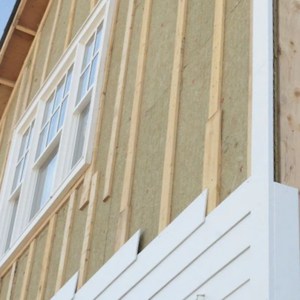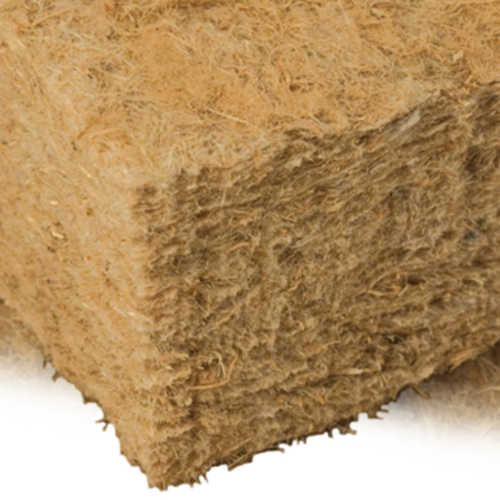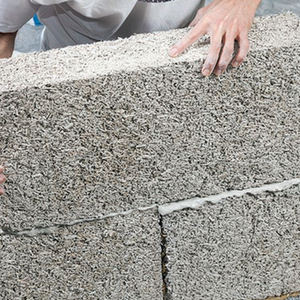
An Idaho company has opened a manufacturing plant for hemp fiber insulation batts, filling a gap in the market for builders seeking low-carbon alternatives to conventional materials.
Hempitecture said its 33,000-sq.-ft. plant in Jerome, Idaho, will produce a range of non-woven hemp products, including HempWool Thermal insulation, a drop-in replacement for mineral wool and fiberglass batts. Initially, the product line will consist of batts in four thicknesses, from 2 in. to 7-1/2 in., and in widths for both 16-in. and 24-in. on-center framing. Later, the company hopes to expand the product line to include hemp fiberboard panels that can be used for continuous insulation.
“Within a short period of time we will have a diverse product array,” Hempitecture CEO and founder Mattie Mead said in an email. “We’re looking into new avenues to have a full portfolio of materials derived from natural fibers that capture carbon and are less abrasive than conventional products.”
The batts have an R-value of 3.69 per inch, about the same as fiberglass, although Mead said the company is experimenting with different blends of fiber to increase its insulating properties. Hempitecture is buying hemp fiber from a company called IND Hemp in neighboring Montana. The fiber is combined with a polymer binder, leaving about 90% of the product a biogenic carbon—that is, a carbon-sequestering material.
“The binder amount is small but it is what currently makes the product feasible,” Mead said. “We are moving in the direction of plant-based bonding materials but unfortunately because they’re newer, they are more expensive. We’re working on balancing cost and the environmental sustainability footprint.”
HempWool is the only insulation on the market that has been certified as biobased by the U.S. Department of Agriculture, according to the company.
Asked whether the company had an Environmental Product Declaration for the insulation, Mead said a lifecycle analysis is underway in conjunction with research at the Oak Ridge National Laboratory. Research conducted by IND Hemp shows that the fiber is carbon-negative, and Hempitecture said it would primarily use materials grown within a 10-hour radius of the factory, further lowering carbon emissions connected with raw materials transport. Power to run the facility comes from renewable sources.
HempWool rated at R-20 costs $1.75 per square foot, compared with 88 cents per square foot for unfaced R-19 fiberglass batts at Home Depot. Unfaced R-13 fiberglass batts are about 65 cents per sq. ft., compared to $1.29 per sq. ft. for hemp. HempWool can be ordered directly from the company.
Like wood-fiber insulation, hemp is attractive from a carbon perspective. But it remains a tiny niche in the overall insulation market. According to Erica Stark, executive director of the National Hemp Association, Hempitecture is the only known producer of fiberglass replacement hemp insulation in the U.S., although Pennsylvania-based Americhanvre offers hempcrete, a spray-on product. In Canada, Nature Fibres produces hemp insulation for a variety of industries, including construction. The Quebec plant opened in 2017 and claims it was the first in North America to specialize in hemp fiber insulation.
Hempitecture’s launch follows by three years the collapse of a Kentucky-based company that also wanted to tap into the hemp fiber marketplace. Sunstrand announced plans to produce hemp fiber batt insulation in 2018, but it filed for Chapter 7 bankruptcy just two years later, in January 2020. It’s not clear how widely available those products ever became.
Scott Gibson is a contributing writer at GBA and Fine Homebuilding magazine.
Weekly Newsletter
Get building science and energy efficiency advice, plus special offers, in your inbox.














7 Comments
Their FAQ says, "HempWool has Class-E fire resistance, so although it is seen as higher on the FSI and SDI, you can protect HempWool between fire-resistant walling (both your exterior siding and interior wallboards). Due to the lack of fire resistance, it is generally approved by a case-by-case project and is not applicable for some projects."
That sounds like a significant challenge. But it goes on to say,
"As we transition to a new manufacturing facility, we are integrating fire-retardants into HempWool®. Expect Fire Resistant HempWool in 2022."
I wonder what the update is on that.
There is a great need for a faced batt insulation product that is widely available and does not require protective gear to handle. Fiberglass and rockwool are both irritants. The photo caption says the mfg claims it is "less abrasive" than fiberglass or rockwool, but does that mean it is still abrasive and still requires protection?
Ten years ago, you could buy faced cotton batts, but cotton insulation seem to be entirely unavailable for the last 2 years, and lambswool batts do not seem to be available faced. This product could fill a need if it were NOT an irritant.
I'm surprised to see mineral wool being spoken of in the same breath with fiberglass as an irritant. In my experience it's far easier to handle.
irene3,
I took it more as saying they could both be said to be that category, rather than that they were comparably bad. Sort of like: I can be a bit irritating, but my neighbour Ron is really hard to work with.
I'd say I have the exact opposite interaction - which is probably what makes this very individualized. I've found MW to be much more irritating on my skin and throat than (modern) fiberglass batts.
Disappointed it isn't completely natural materials. Was hoping for a product that would be biodegradable at the end of its use. Wood fiber like TimberFill seems more environmentally friendly, since it doesn't require fertilizer or irrigation and is fully biodegradable.
They do say they are working on natural binders, I've never heard of TimberFill until your comment and it seems they are very local to Maine. But it's great to see that product is available! The more environmentally friendly options out there the better.
Having grown hemp myself it really does not need much help in the way of fertilization or irrigation and my understanding is that it sequesters close to 2x more carbon than forests (could help offset the synthetic binders). It would be great to see natural fiber building products of many varieties grown and processed locally all over.
Log in or create an account to post a comment.
Sign up Log in